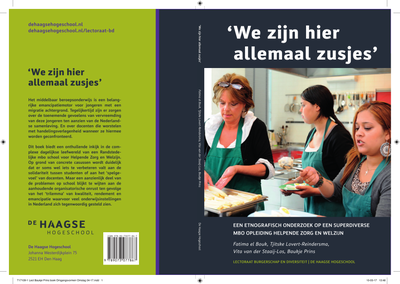Studentenwelzijn blijkt de laatste jaren meer onder druk te staan en staat dan ook hoog op de agenda in het hbo en wo. Ook bij Fontys Pedagogiek is er in toenemende mate aandacht voor studentenwelzijn, zeker sinds de coronapandemie. In 2020 is de voltijdopleiding Pedagogiek van Fontys overgestapt naar een nieuw 'leergroep-curriculum'. Vanuit het Lectoraat Opvoeden voor de Toekomst hebben Aafke Baars-Seebregts en Guusje Staring een praktijkgericht, exploratief onderzoek uitgevoerd vanuit de vraag: Hoe kunnen de coachende onderwijsprofessionals binnen het leergroep-curriculum van de voltijdopleiding Pedagogiek handelen op een manier die bijdraagt aan het welzijn van de Pedagogiekstudent? In deze publicatie doen zij verslag van zowel de literatuurverkenning als het praktijkonderzoek met collega-coaches, studenten en een lid van de ontwikkelgroep.
DOCUMENT

Het middelbaar beroepsonderwijs is een belangrijke emancipatiemotor voor jongeren met een migratie achtergrond. Tegelijkertijd zijn er zorgen over de toenemende gevoelens van vervreemding van deze jongeren ten aanzien van de Nederlandse samenleving. En over docenten die worstelen met handelingsverlegenheid wanneer ze hiermee worden geconfronteerd. Dit boek biedt een onthullende inkijk in de complexe dagelijkse leefwereld van een Randstedelijke mbo school voor Helpende Zorg en Welzijn. Op grond van concrete casussen wordt duidelijk dat er soms wel iets te verbeteren valt aan de solidariteit tussen studenten of aan het ‘spelgevoel’ van docenten. Maar een aanzienlijk deel van de problemen op school blijkt te wijten aan de aanhoudende organisatorische onrust ten gevolge van het ‘trilemma’ van kwaliteit, rendement en emancipatie waarvoor veel onderwijsinstellingen in Nederland zich tegenwoordig gesteld zien.
DOCUMENT

In dit hoofdstuk wordt het Nederlandse beleid geschetst van het tegengaan van radicalisering en het voorkomen van terroristisch geweld. Hierin neemt het ‘Actieprogramma integrale aanpak Jihadisme’ een belangrijke plaats in. Besproken wordt wat er goed gaat en wat de ontwikkelingsvragen zijn. Het hoofdstuk eindigt met een beschouwing over de behoefte aan sociale innovatie. Aangezien een aantal preventieve interventies behoorlijk ingrijpend kunnen zijn, is het zaak om bij de uitvoering te letten op eenduidigheid en adequate rechtsbescherming.
MULTIFILE

Dit project onderzoekt de samenhang tussen zingeving, welzijn, en onderwijs. Aan de hand van diepte-interviews kijkt promovenda Marije Verkerk met jongeren en jongvolwassenen hoe zij betekenis geven aan het leven, met name aan moeilijke ervaringen. Daarbij kijkt zij ook naar de vraag wat (levensbeschouwelijk) onderwijs hierbij kan betekenen.
